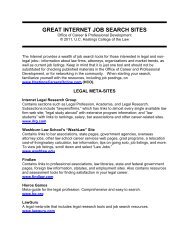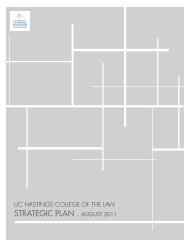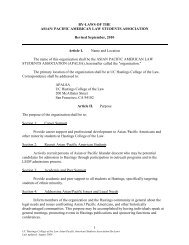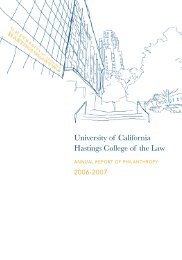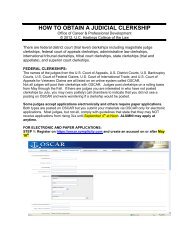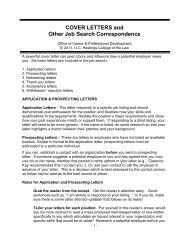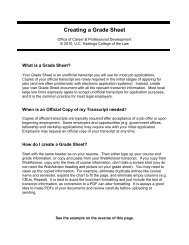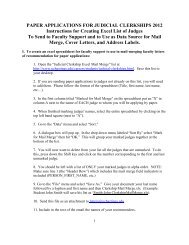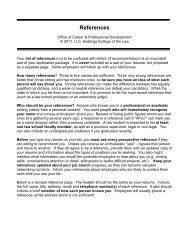Syllabus - Hastings College of the Law
Syllabus - Hastings College of the Law
Syllabus - Hastings College of the Law
Create successful ePaper yourself
Turn your PDF publications into a flip-book with our unique Google optimized e-Paper software.
I. CLASS POLICIES<br />
CIVIL PROCEDURE II<br />
FALL 2011<br />
Pr<strong>of</strong>. Stefano Moscato<br />
Office: Room 346 (200 McAllister St., 3rd floor)<br />
Tel.: 310-384-6429<br />
E-mail: moscato@uchastings.edu<br />
A. Attendance, preparation and participation<br />
I expect you to regard class attendance as you would a court appearance on behalf <strong>of</strong> a client.<br />
Thus, you should be punctual, well prepared, and ready to fully participate in class discussion.<br />
Voluntary participation also is strongly encouraged.<br />
I reserve <strong>the</strong> right to lower your final grade for <strong>the</strong> course for excessive absences and/or lack <strong>of</strong><br />
preparation when called on.<br />
B. Grading<br />
Subject to <strong>the</strong> potential for your final grade being reduced as set forth above, 100% <strong>of</strong> your final<br />
grade for this course will be determined by <strong>the</strong> final exam. The final exam will be an open-book,<br />
three-hour in-class examination and will cover <strong>the</strong> entire semester’s material for this course. The<br />
exam will comprise <strong>of</strong> several essay questions (no multiple choice). I will discuss <strong>the</strong> exact<br />
format <strong>of</strong> <strong>the</strong> exam in more depth later in <strong>the</strong> semester, and will direct you to exams I have given<br />
in <strong>the</strong> past as guides/study tools.<br />
C. Office Hours<br />
My <strong>of</strong>fice hours are Thusdays from 1:15pm - 3:00pm. You also are welcome to make an<br />
appointment to meet with me at different time.<br />
II. READING ASSIGNMENTS<br />
Reading assignments indicated as “Marcus” refer to <strong>the</strong> hard-cover casebook, Marcus,<br />
Redish, Sherman & Pfander, CIVIL PROCEDURE: A MODERN APPROACH, Fifth Edition<br />
(Thomson/West 2009).<br />
Reading assignments indicated as “Supplement” refer to supplemental cases and o<strong>the</strong>r<br />
materials which you can download from <strong>the</strong> course website.<br />
Reading assignments indicated as “COL” refer to Marcus, Civil Procedure II Choice <strong>of</strong> <strong>Law</strong><br />
Handout (2010), which you also can download from <strong>the</strong> course website.<br />
When you are assigned to read a statute in <strong>the</strong> United States Code, a portion <strong>of</strong> <strong>the</strong> United<br />
States Constitution, one <strong>of</strong> <strong>the</strong> Federal Rules <strong>of</strong> Civil Procedure, or a state statutory<br />
provision, you can find those in Kane & Levine, CIVIL PROCEDURE IN CALIFORNIA<br />
1
(Thomson/West 2011). Students who already own prior editions <strong>of</strong> <strong>the</strong> Kane paperback can<br />
use those instead—I don’t believe that any <strong>of</strong> <strong>the</strong> rules/statutes/provisions we are covering in<br />
this course have materially changed in <strong>the</strong> last few years. You can also easily find <strong>the</strong>m online.<br />
Page references in this <strong>Syllabus</strong> are to <strong>the</strong> 2011 edition.<br />
We will move through <strong>the</strong> syllabus in <strong>the</strong> order indicated below. Since we will meet for one hour<br />
on Mondays and two hours on Thursdays, you should plan on reading <strong>the</strong> next topic on <strong>the</strong><br />
syllabus for Mondays and <strong>the</strong> next two topics for Thursdays. However, as you might notice,<br />
<strong>the</strong>re are fewer assignments than <strong>the</strong>re are class hours in <strong>the</strong> semester. That is because we will<br />
sometimes spend multiple class sessions on a single topic, and we also will from time to time<br />
pause to take up class discussion problems I will assign you to prepare in advance <strong>of</strong> class. I will<br />
instruct you at <strong>the</strong> end <strong>of</strong> each class whe<strong>the</strong>r to deviate from <strong>the</strong> standard reading plan for <strong>the</strong><br />
next class.<br />
<strong>Syllabus</strong>:<br />
CHOOSING THE FORUM: GEOGRAPHICAL LOCATION<br />
1. The Traditional Constitutional Bases for Jurisdiction Over <strong>the</strong> Parties or Their<br />
Property -- Pennoyer v. Neff<br />
U.S. Constitution, 14 th Amendment (Kane, 215)<br />
Marcus, 680-693<br />
2. Evolution <strong>of</strong> <strong>the</strong> Traditional “Power” Theory <strong>of</strong> Personal Jurisdiction -- Hess,<br />
Implied Consent and Corporate “Presence”<br />
Marcus, 696-700<br />
3. The Shift to “Minimum Contacts” -- International Shoe<br />
Marcus, 700-707<br />
4. Early Applications <strong>of</strong> International Shoe -- McGee, Hanson, Gray<br />
Marcus, 707-713<br />
5. State Long-Arm Statutes; Personal Jurisdiction in Federal Court<br />
California’s Long-Arm Statute, Cal. Code Civ. Proc. § 410.10 (Kane, 329)<br />
Long-Arm Statutes <strong>of</strong> Illinois & New York (Kane, 614-617)<br />
Marcus, 713-719<br />
Supplement: Bensusan Restaurant Corp. v. King<br />
6. Refining <strong>the</strong> Minimum Contacts Alalysis for Modern Interstate Contacts -- World-<br />
Wide Volkswagen<br />
Marcus, 719-736<br />
Supplement: Adams, The Story Behind World-Wide VW<br />
2
7. Refining <strong>the</strong> Minimum Contacts Alalysis for Intentional Tortious Conduct Causing<br />
Injury in <strong>the</strong> Forum State -- Calder, Kulko<br />
Marcus, 736-742<br />
Supplement: Kulko v. Superior Court<br />
8. Minimum Contacts and Contractual Relationships -- Burger King<br />
Marcus, 743-756<br />
9. Minimum Contacts and <strong>the</strong> “Stream <strong>of</strong> Commerce” -- Asahi Metal, Nicastro<br />
Marcus, 756-766<br />
Supplement: McIntyre v. Nicastro<br />
10. Internet and O<strong>the</strong>r Technological Contacts<br />
Marcus, 766-780<br />
11. Jurisdiction Based Upon Power Over <strong>the</strong> Defendant’s Property -- Pennoyer revisited,<br />
Harris v. Balk, Shaffer v. Heitner<br />
Review Pennoyer v. Neff (Marcus, 681-687 and Note 2 pp. 688-690)<br />
Marcus, 693-696, 781-796<br />
12. Jurisdiction Based Upon Physical Presence -- Burnham<br />
Marcus, 799-811<br />
13. “General” Personal Jurisdiction: Permitting <strong>the</strong> Exercise <strong>of</strong> Personal Jurisdiction Even<br />
Where <strong>the</strong> Claim is Unrelated to <strong>the</strong> Defendant’s Activities in <strong>the</strong> Forum State<br />
Supplement: Helicopteros Nacionales de Colombia v. Hall<br />
Marcus, 815-817 (notes 1-4)<br />
Supplement: Goodyear Dunlop Tires v. Brown<br />
CHOOSING THE FORUM: STATE VS. FEDERAL COURT<br />
14. Federal Court Subject-Matter Jurisdiction Based on Diversity <strong>of</strong> Citizenship:<br />
Determining <strong>the</strong> Parties’ “Citizenship”<br />
U.S. Constitution, Article III (Kane, 212-213)<br />
28 U.S.C. § 1332 (Kane, 231-235)<br />
Marcus, 850-858 (through note 6)<br />
Supplement: Hertz Corp. v. Friend<br />
15. Satisfying <strong>the</strong> “Amount in Controversy” Requirement for Diversity Jurisdiction<br />
Marcus, 861-864<br />
Supplement: AFA Tours v. Whitchurch<br />
3
16. Federal Court Subject-Matter Jurisdiction in Cases “Arising Under” Federal <strong>Law</strong><br />
(a.k.a. “Federal Question” Jurisdiction) -- Mottley and its progeny<br />
U.S. Constitution, Article III (Kane, 212-213)<br />
28 U.S.C. §§ 1331, 1337, 1338, 1343 (Kane, 231, 236-238)<br />
Marcus, 864-873<br />
17. Refining <strong>the</strong> Statutory “Arising Under” Test: State <strong>Law</strong> Claims with Federal<br />
Ingredients<br />
Marcus, 873-888<br />
18. Federal Court Subject-Matter Jurisdiction Over Supplemental State <strong>Law</strong> Claims<br />
and Non-Diverse Parties -- United Mine Workers v. Gibbs and its progeny<br />
Review Fed. R. Civ. P. 13, 14, 18, 19, 20, 24 (Kane, 33-36, 45-48, 62-64)<br />
Marcus, 888-894 (through n.2)<br />
19. The Supplemental Jurisdiction Statute<br />
28 U.S.C. § 1367 (Kane, 238-239)<br />
Marcus, 894 n.3-914<br />
20. Federal Court Subject-Matter Jurisdiction Over Cases Removed from State Court<br />
by Defendant<br />
28 U. S.C. §§ 1441, 1447 (Kane, 245-246, 248-249)<br />
Marcus, 914-923<br />
ADDITIONAL LIMITATIONS ON WHERE A LAWSUIT MAY BE<br />
MAINTAINED<br />
21. Choosing <strong>the</strong> Proper Venue<br />
28 U. S.C. § 1391(a)-(d) (Kane, 240)<br />
Marcus, 830-837<br />
22. Transfer <strong>of</strong> Venue and Forum Non Conveniens<br />
28 U.S.C. §§ 1404(a) and 1406 (Kane, 242-243)<br />
Marcus, 837-849<br />
4
ASCERTAINING THE APPLICABLE LAW IN FEDERAL COURT<br />
DIVERSITY CASES: CHOOSING BETWEEN FEDERAL AND STATE<br />
LAW<br />
23. Evolution <strong>of</strong> <strong>the</strong> Erie Doctrine<br />
Rules <strong>of</strong> Decision Act, 28 U.S.C. § 1652 (Kane, 251)<br />
Marcus, 924-935<br />
24. Untangling Erie’s Substance/Procedure Distinction -- York, Byrd<br />
Marcus, 935-953<br />
25. Erie And <strong>the</strong> Federal Rules <strong>of</strong> Civil Procedure -- Hanna and its progeny<br />
Rules Enabling Act, 28 U.S.C. § 2072 (Kane, 268)<br />
Marcus, 953-968<br />
Supplement: Walker v. Armco Steel<br />
Supplement: Shady Grove Orthopedic Assocs. v. Allstate Ins. Co.<br />
CHOICE OF LAW: CHOOSING AMONG THE POSSIBLY PERTINENT<br />
LAWS OF DIFFERENT STATES<br />
26. Background; The Traditional (First Restatement) Approach<br />
COL, 1-28<br />
27. Escape Devices to Avoid <strong>the</strong> Traditional Rule<br />
COL, 43-54<br />
28. The “Governmental Interest” Approach: Discerning Interests and Conflicts<br />
COL, 62-64, 77-96<br />
29. The “Governmental Interest” Approach: Resolving Actual Conflicts<br />
COL, 96-107, 112-122<br />
30. The Second Restatement “Most Significant Relationship” Approach<br />
COL, 122-148<br />
5



